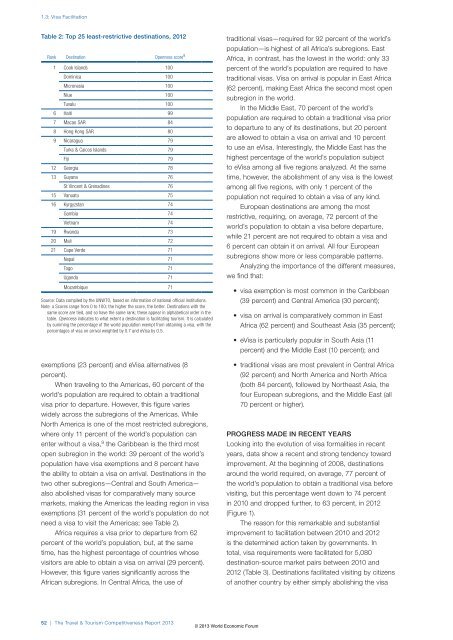The Travel & Tourism Competitiveness Report 2013
The Travel & Tourism Competitiveness Report 2013
The Travel & Tourism Competitiveness Report 2013
You also want an ePaper? Increase the reach of your titles
YUMPU automatically turns print PDFs into web optimized ePapers that Google loves.
1.3: Visa Facilitation<br />
Table 2: Top 25 least-restrictive destinations, 2012<br />
Rank Destination Openness score a<br />
1 Cook Islands 100<br />
Dominica 100<br />
Micronesia 100<br />
Niue 100<br />
Tuvalu 100<br />
6 Haiti 99<br />
7 Macao SAR 84<br />
8 Hong Kong SAR 80<br />
9 Nicaragua 79<br />
Turks & Caicos Islands 79<br />
Fiji 79<br />
12 Georgia 78<br />
13 Guyana 76<br />
St Vincent & Grenadines 76<br />
15 Vanuatu 75<br />
16 Kyrgyzstan 74<br />
Gambia 74<br />
Vietnam 74<br />
19 Rwanda 73<br />
20 Mali 72<br />
21 Cape Verde 71<br />
Nepal 71<br />
Togo 71<br />
Uganda 71<br />
Mozambique 71<br />
Source: Data compiled by the UNWTO, based on information of national official institutions.<br />
Note: a Scores range from 0 to 100; the higher the score, the better. Destinations with the<br />
same score are tied, and so have the same rank; these appear in alphabetical order in the<br />
table. Openness indicates to what extent a destination is facilitating tourism. It is calculated<br />
by summing the percentage of the world population exempt from obtaining a visa, with the<br />
percentages of visa on arrival weighted by 0.7 and eVisa by 0.5.<br />
exemptions (23 percent) and eVisa alternatives (8<br />
percent).<br />
When traveling to the Americas, 60 percent of the<br />
world’s population are required to obtain a traditional<br />
visa prior to departure. However, this figure varies<br />
widely across the subregions of the Americas. While<br />
North America is one of the most restricted subregions,<br />
where only 11 percent of the world’s population can<br />
enter without a visa, 9 the Caribbean is the third most<br />
open subregion in the world: 39 percent of the world’s<br />
population have visa exemptions and 8 percent have<br />
the ability to obtain a visa on arrival. Destinations in the<br />
two other subregions—Central and South America—<br />
also abolished visas for comparatively many source<br />
markets, making the Americas the leading region in visa<br />
exemptions (31 percent of the world’s population do not<br />
need a visa to visit the Americas; see Table 2).<br />
Africa requires a visa prior to departure from 62<br />
percent of the world’s population, but, at the same<br />
time, has the highest percentage of countries whose<br />
visitors are able to obtain a visa on arrival (29 percent).<br />
However, this figure varies significantly across the<br />
African subregions. In Central Africa, the use of<br />
52 | <strong>The</strong> <strong>Travel</strong> & <strong>Tourism</strong> <strong>Competitiveness</strong> <strong>Report</strong> <strong>2013</strong><br />
traditional visas—required for 92 percent of the world’s<br />
population—is highest of all Africa’s subregions. East<br />
Africa, in contrast, has the lowest in the world: only 33<br />
percent of the world’s population are required to have<br />
traditional visas. Visa on arrival is popular in East Africa<br />
(62 percent), making East Africa the second most open<br />
subregion in the world.<br />
In the Middle East, 70 percent of the world’s<br />
population are required to obtain a traditional visa prior<br />
to departure to any of its destinations, but 20 percent<br />
are allowed to obtain a visa on arrival and 10 percent<br />
to use an eVisa. Interestingly, the Middle East has the<br />
highest percentage of the world’s population subject<br />
to eVisa among all five regions analyzed. At the same<br />
time, however, the abolishment of any visa is the lowest<br />
among all five regions, with only 1 percent of the<br />
population not required to obtain a visa of any kind.<br />
European destinations are among the most<br />
restrictive, requiring, on average, 72 percent of the<br />
world’s population to obtain a visa before departure,<br />
while 21 percent are not required to obtain a visa and<br />
6 percent can obtain it on arrival. All four European<br />
subregions show more or less comparable patterns.<br />
Analyzing the importance of the different measures,<br />
we find that:<br />
• visa exemption is most common in the Caribbean<br />
(39 percent) and Central America (30 percent);<br />
• visa on arrival is comparatively common in East<br />
Africa (62 percent) and Southeast Asia (35 percent);<br />
• eVisa is particularly popular in South Asia (11<br />
percent) and the Middle East (10 percent); and<br />
• traditional visas are most prevalent in Central Africa<br />
(92 percent) and North America and North Africa<br />
(both 84 percent), followed by Northeast Asia, the<br />
four European subregions, and the Middle East (all<br />
70 percent or higher).<br />
PROGRESS MADE IN RECENT YEARS<br />
Looking into the evolution of visa formalities in recent<br />
years, data show a recent and strong tendency toward<br />
improvement. At the beginning of 2008, destinations<br />
around the world required, on average, 77 percent of<br />
the world’s population to obtain a traditional visa before<br />
visiting, but this percentage went down to 74 percent<br />
in 2010 and dropped further, to 63 percent, in 2012<br />
(Figure 1).<br />
<strong>The</strong> reason for this remarkable and substantial<br />
improvement to facilitation between 2010 and 2012<br />
is the determined action taken by governments. In<br />
total, visa requirements were facilitated for 5,080<br />
destination-source market pairs between 2010 and<br />
2012 (Table 3). Destinations facilitated visiting by citizens<br />
of another country by either simply abolishing the visa<br />
© <strong>2013</strong> World Economic Forum

















